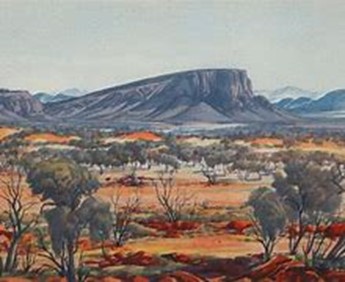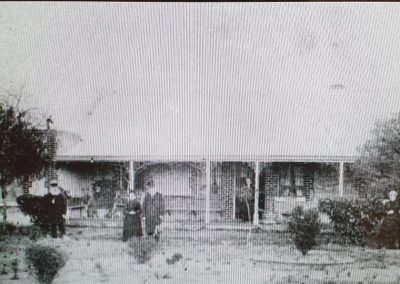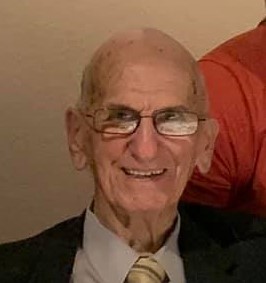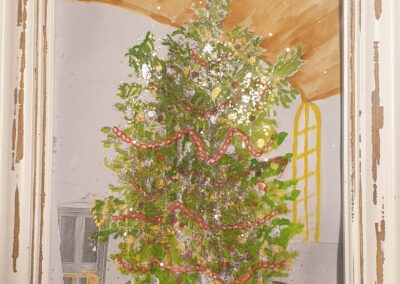Darlene Cooper, of Luhrs Cottage, Light Pass has been researching the Light Pass Men’s Agricultural Bureau. In the December 1923 minutes, she came across this account of a talk given to the Bureau members by Pastor JJ Stolz. He speaks of his recent trip to Central Australia visiting the Mission station at Hermannsburg. Pastor Stolz was the grandson of Pastor G.J Rechner. After Rechner died in August 1900, Pastor Stolz became the minister of Strait Gate Lutheran Church. He served the congregation for 30 years, and then took on the position of President of the Lutheran Church. Pastor Stolz was a member of the Ag Bureau from 1923-1929. (Featured image is a painting by artist Albert Namatjira)
From the Minutes (and with thanks to a very comprehensive minutes taker!)
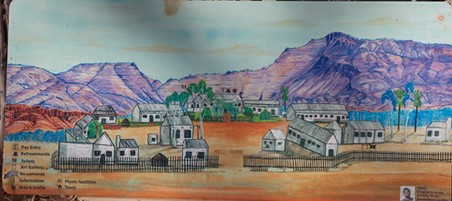
Hermannsburg Mission
”J.J Stolz addressed the meeting with a very instructive and interesting address on his trip to the Mission Station in The MacDonnell Ranges in Central Australia.
He divided his remarks under three headings:
(1) Parts I traversed.
(2) People I met
(3) Problems
Dealing with the parts traversed first, the speaker gave us a vivid description of the class of country passed on the way and mentioned the possibilities of settlement and expansion. He also paid particular attention to places of marked interest as Leigh’s Creek, the only coal mine in South Australia. It is at present closed down and is likely to remain for centuries as it takes one ton of Newcastle coal to burn one ton of Leigh’s Creek coal. From Leigh’s Creek onwards to Herrgott Springs or Maree it is desert country, and the possibility of cutting a channel from Spencers Gulf to Lake Eyre has been discussed. The lowest below sea level is 30ft and deepest cut to let the water in would be 60ft, the lecturer said that he stayed on a station 90 miles from central Lake Eyre and the highest point there was 3 feet below sea level.
Herrgott Springs is the centre of the desert country and owes its existence to the artesian water obtainable there.
After leaving Maree the route passes through sandhills until it arrives at Oodnadatta, the end of the railway. Oodnadatta is quite a decent little town and like other towns in Central Australia, it owes its life to the artesian water obtainable there. From Oodnadatta the traveller follows the overland telegraph line until arriving at Charlotte Waters, a telegraph station built like a fortress, to ward off attacks by the natives.
One interesting place on this route is Dew Drop Inn at 10 mile bore. It is a hotel without a licence but sometimes runs dry on account of the thirsty nature of the climate. Another place of interest passed is the Old Crown Cattle Station owned by Sir Sydney Kidman.
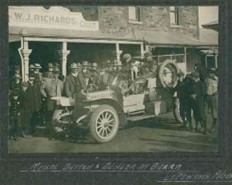
Aunger and Dutton at Burra, 1908 – the first journey by car from Adelaide to Darwin (Photo; State Library SA Collection)
The next important place of call is Horseshoe Bend on the Finke River and after leaving here the route passes through the most difficult stage of the journey, the sand hills and drift, and until recently the plague of motorists. Mr Murray Aunger invented a tyre which made it possible for a motorist to cross this 25 miles of sand in 6 hours where as a trap or buggy takes 3 days. (Editors note: Mr Aunger was a talented mechanic and motor enthusiast, read more about his epic journeys here).
Following the Finke River, the traveller comes to the MacDonnell Ranges where the scenery changes and instead of the desert country encountered from Leigh’s Creek onwards, he sees abundant vegetation and grasses. The mulga and desert grow so thickly that in places it is almost impenetrable. The desert oak is a specific hardwood suitable for building purposes. The waving porcupine grass looks very much like a crop of wheat and feed is abundant. Water can be obtained on the Mission Station at a depth from 20 to 30 feet.
The speaker described the class of country with its gorges, the beauty spots of the MacDonnell Ranges, and the scenery to be witnessed there, among the best being the Glen of Palms where grows a palm that is not encountered in any other part of the world.
Next the speaker dealt with the people met on the way and he paid a fine tribute to the endurance and the work of the real Australian stockmen, describing his life and work and the hardships and dangers that he met with.
Then he mentioned the heroism of the few white women he met in that desert country, among them being the missionary’s wife and the hostess of the Horseshoe Bend Inn, also a young lady on her way as governess to the children of a central Australian station.
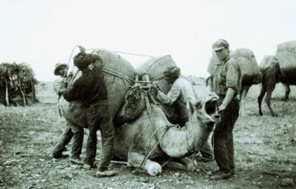
Camaleers, Hergott Springs (Photo: State Library of SA). JJ was impressed by the people of the outback.
Next person of note he met was the driver of the Camel Mail on the route and the speaker described his life and work vividly. He earns all of his 6 pound 10 pence per week.
Next came the problems to be faced and here Mr Stolz gave us a description of the work carried on by the Mission people and its effect on the natives. He said that the natives were becoming useful and industrious under the leadership of the missionaries and one of their greatest problems was to find employment for the rapidly increasing numbers. They intend starting work at gardening and the leather industry and Mr Stolz gave us an example of the industry of the natives in motor road that they built for tourists to visit and inspect the beauties of the Glen Palms.
He said that the natives are gradually obtaining a high standard of morality and were free from diseases that in many cases are gradually killing out the Australian aborigines.
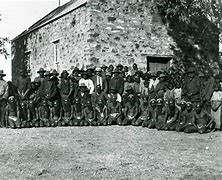
Hermannsburg mission
He touched on the political aspect and was emphatic in his remarks that a north South Railway was urgently needed, and that something must be done to preserve the growing number of natives.
He also explained the possibilities of preserving the waters of the Finke and other rivers of the MacDonnell Ranges and said that it was easy to do, as there were many natural reservoirs and all that was needed was an embankment blocking one of the deep gorges between the Ranges.
This was an address enjoyed and appreciated by everyone present and it was made doubly so by the inclusion of little personal anecdotes and experiences.
A hearty vote of thanks was moved by Mr A Chapman and seconded by Mr L Koop to which Mr Stolz responded saying that he was only too pleased to have been able to entertain the Bureau with a description of life and work in Central Australia“.
(editors note: The history of missions is a complex and often contentious one. In reproducing this account, we are not seeking to present the rights or wrongs of mission work. The missionaries went out in good faith and cared deeply for the welfare of those they worked with. They appreciated their language and culture, and many of them were instrumental in recording and preserving these.)

